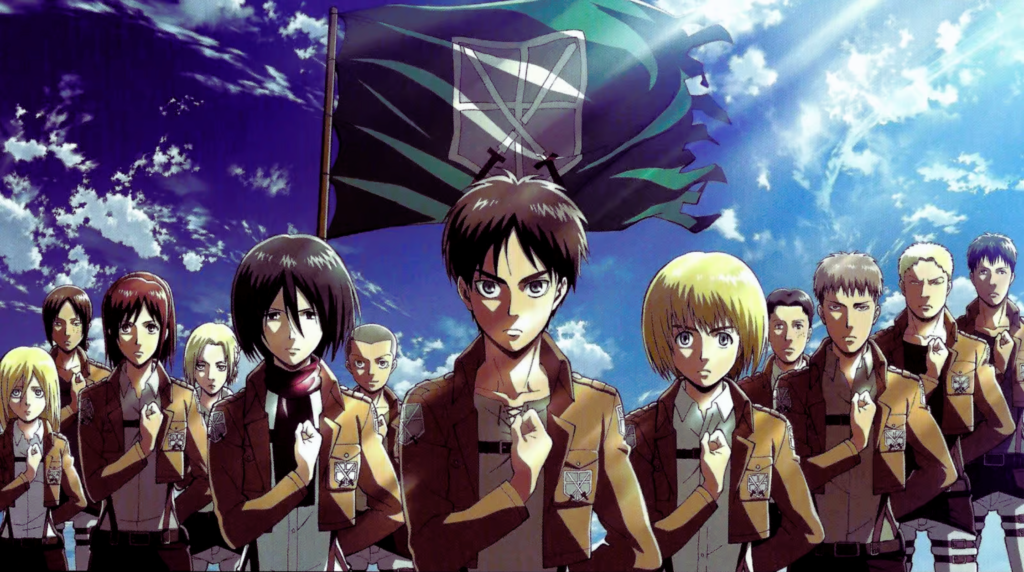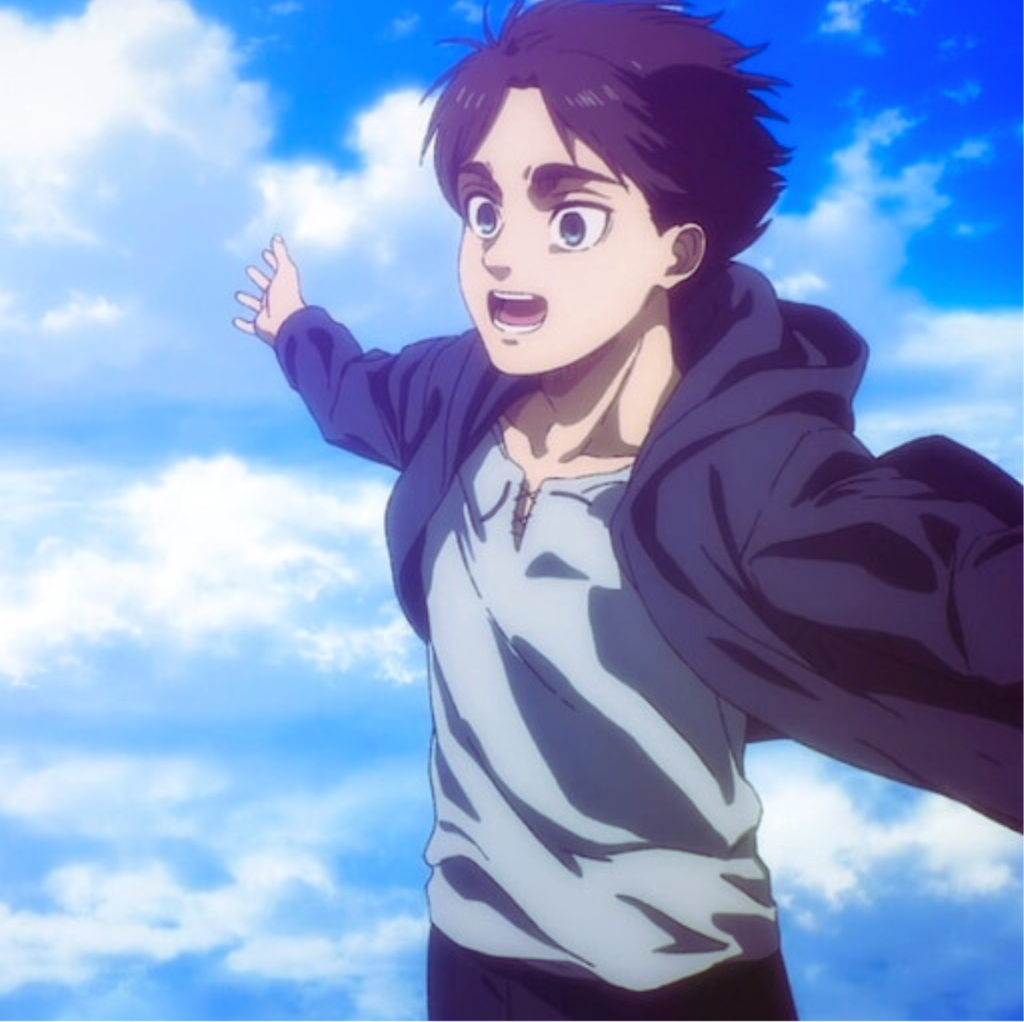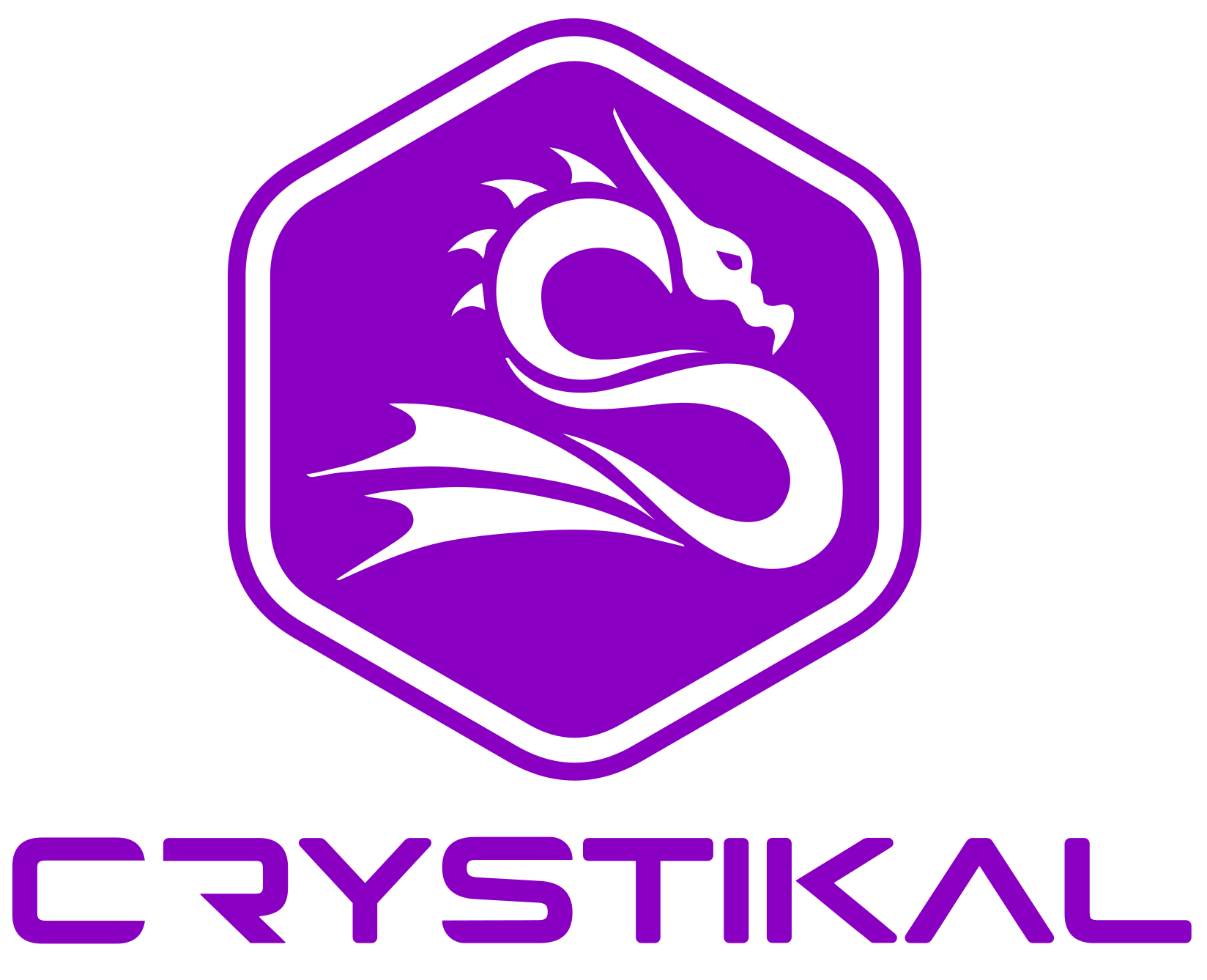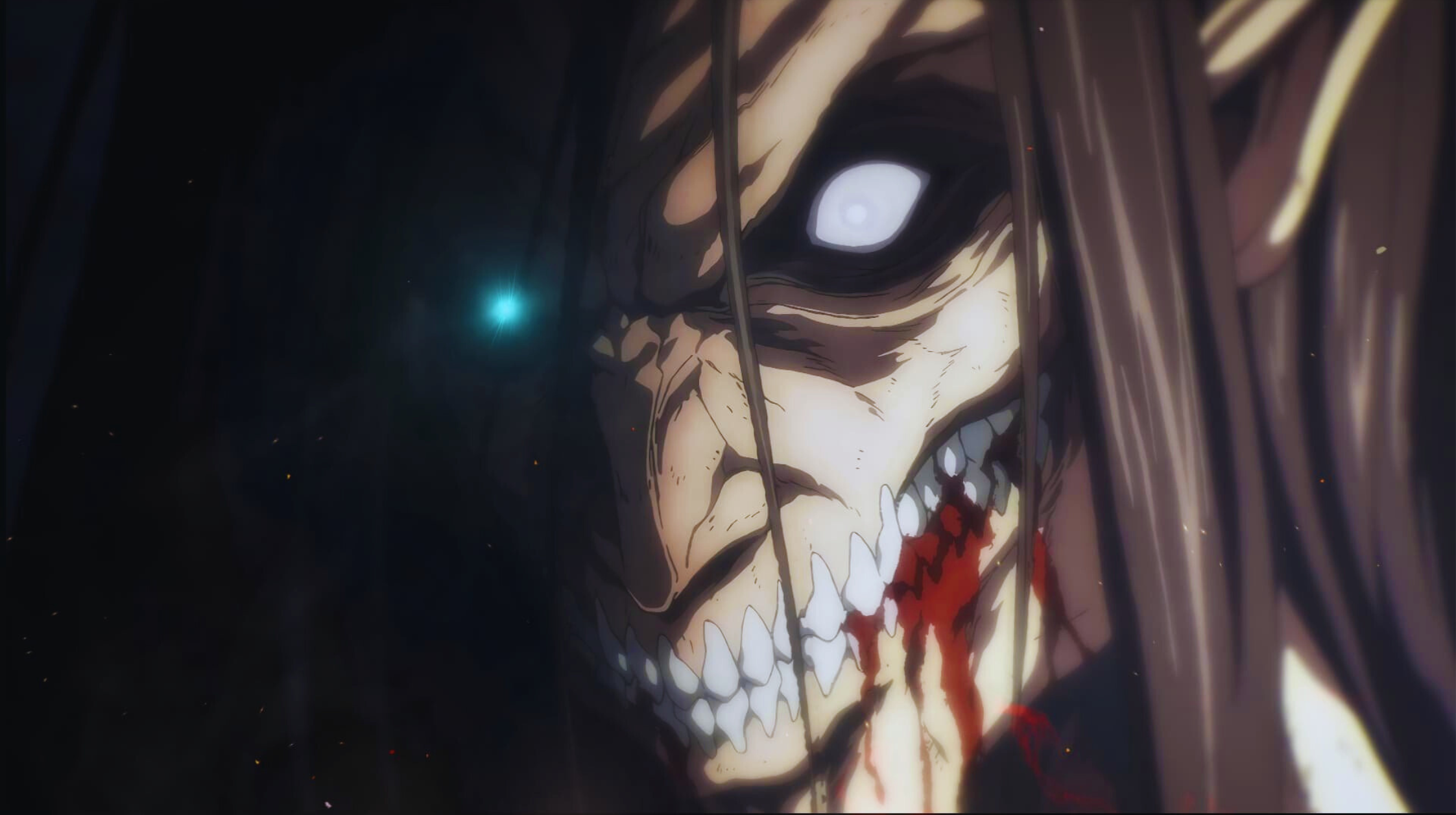Introduction:
In the realm of anime, few series have achieved the same level of acclaim and global recognition as “Attack on Titan.” Created by Hajime Isayama, this dark fantasy epic has captivated audiences worldwide with its gripping storyline, visceral action, and complex characters. Join me as we delve into the harrowing world of “Attack on Titan” and explore what makes it a titan among anime.

The Plot (Attack on Titan)
“Attack on Titan” is set in a world where humanity resides within enormous walled cities to protect themselves from giant humanoid creatures known as Titans, who devour humans without mercy. The story follows Eren Yeager, his adoptive sister Mikasa Ackerman, and their friend Armin Arlert as they join the military to fight against the Titans after their hometown is destroyed by one of the colossal creatures. As they uncover the mysteries surrounding the Titans and their own identities, they become embroiled in a desperate struggle for survival against overwhelming odds.

Attack on Titan’s Compelling Cast: A Look at Key Characters
Attack on Titan‘s success hinges not just on its gripping plot and intense action, but also on its well-developed characters. Each character grapples with their own traumas, ambitions, and moral dilemmas, creating a dynamic and relatable cast that resonates with viewers. Here’s a closer look at some of the key players in this dark fantasy world:
Eren Yeager: The Rage-Fueled Protagonist
Eren Yeager serves as the story’s protagonist. Witnessing his mother’s gruesome death at the hands of a Titan ignites a burning desire for revenge within him. Fueled by this rage, Eren becomes fiercely determined to eradicate all Titans. He possesses raw strength and unwavering determination, pushing himself relentlessly to become a skilled Titan slayer. However, his impulsiveness and emotional outbursts can cloud his judgment, leading him into dangerous situations.
Mikasa Ackerman: The Fiercely Loyal Warrior
Mikasa Ackerman is Eren’s adoptive sister and a formidable warrior. Bound by a deep loyalty stemming from a traumatic past, Mikasa vows to protect Eren at all costs. Her combat skills are unmatched, making her a lethal force on the battlefield. She possesses exceptional agility and swordsmanship, acting as a constant shield for Eren. Despite her fierce demeanor, Mikasa harbors a wellspring of compassion and a strong moral compass. However, her unwavering devotion to Eren can sometimes blind her to his recklessness, creating internal conflicts.
Armin Arlert: The Strategist with a Gentle Heart
Armin Arlert, Eren’s childhood friend, stands in stark contrast to him physically. Lacking Eren’s raw strength, Armin shines with his strategic mind and tactical thinking. He devours knowledge, constantly seeking to understand the world around him. Armin serves as the voice of reason and empathy, often offering a counterpoint to Eren’s impulsiveness. Despite his slight stature, Armin possesses remarkable courage and unwavering determination. His strategic genius proves invaluable on the battlefield, and his compassionate nature allows him to see beyond the rage and hatred that consumes others. However, Armin’s gentle heart can lead him to question the brutal realities of war and grapple with its moral complexities.
Levi Ackerman: Humanity’s Strongest Soldier
Levi Ackerman is a captain within the Survey Corps and is widely regarded as humanity’s strongest soldier. He is a master swordsman with unmatched combat skills and a reputation for ruthlessness. Levi’s stoic demeanor masks a deep sense of responsibility for his squad. Despite his cold exterior, he demonstrates loyalty and compassion for his comrades, especially those under his command.
Erwin Smith: The Strategic Leader
Erwin Smith is the former commander of the Survey Corps. A brilliant strategist with a ruthless streak, Erwin leads the Corps on daring expeditions beyond the walls, prioritizing the pursuit of knowledge about the Titans above all else. He is willing to sacrifice lives, even his own soldiers’, to achieve his goals. However, Erwin’s determination and strategic brilliance prove instrumental in humanity’s fight for survival.
Reiner Braun and Bertolt Hoover: The Deceptive Warriors
Reiner Braun and Bertolt Hoover are initially presented as fellow soldiers from another district within the Walls. However, a shocking revelation later unveils them as Titan Shifters, colossal warriors from Marley, a nation beyond the walls, tasked with retrieving the Founding Titan power held by Eren. Their conflicting loyalties and the weight of their mission create complex internal struggles.
Historia Reiss: The Enigma with Royal Blood
Historia Reiss is a mysterious young woman who possesses royal blood. Initially introduced as a timid and reserved individual, she undergoes significant character development as the story progresses. Historia’s lineage plays a crucial role in the power dynamics within the Walls and becomes a focal point of the narrative.
This is just a glimpse into the rich tapestry of characters that populate the world of Attack on Titan. Every character, from the main protagonists to the supporting cast, contributes to the story’s depth and emotional impact. Their growth, sacrifices, and struggles keep viewers engaged and invested in the fate of humanity within the walls.
Attack on Titan: A Tapestry of Themes and Symbolism
Attack on Titan’s captivating narrative transcends the realm of pure action and delves into a rich tapestry of thought-provoking themes and potent symbolism. These elements provide depth and complexity, allowing the series to resonate with viewers on a profound level. Let’s explore some of the key themes and symbols that permeate the world of Attack on Titan:

Themes:
- The Horrors of War: The series unflinchingly portrays the brutality and devastation of war. The constant threat of Titan attacks and the desperate struggle for survival paint a grim picture of the human cost of conflict. The violence is visceral, forcing viewers to confront the harsh realities of war and its lasting psychological impact on characters.
- The Cycle of Violence: Attack on Titan explores the cyclical nature of violence. Hatred and vengeance fuel conflict, leading to further bloodshed. The history between Eldians and Marleyans exemplifies this cycle, with each side perpetuating atrocities in the name of revenge or self-preservation. The series challenges viewers to consider ways to break free from this cycle and seek solutions beyond violence.
- The Loss of Innocence: The characters in Attack on Titan are forced to mature rapidly in the face of constant danger. Witnessing horrific events shatters their innocence and forces them to confront the harsh realities of the world. The loss of innocence is a recurring theme, emphasizing the psychological burden placed upon those living in such a perilous environment.
- The Question of Freedom: Freedom is a central theme, but its definition is constantly challenged. Are humans truly free within the Walls, or are they simply imprisoned by fear? The characters grapple with the concept of freedom as they fight for the right to exist beyond the walls and explore the truth about the world. The series explores the limitations of freedom and the sacrifices necessary to achieve it.
- The Power of Choice and Morality: Attack on Titan presents viewers with complex moral dilemmas. Characters are forced to make difficult choices, often with devastating consequences. The series challenges viewers to consider the moral implications of their actions and the potential consequences of pursuing vengeance or self-preservation. The line between right and wrong blurs, forcing viewers to question their own moral compass.
Symbolism:
- The Walls: The colossal Walls represent humanity’s attempt to control their destiny and shield themselves from danger. However, they also symbolize isolation, ignorance, and a false sense of security. The Walls become a physical manifestation of the fear and limitations that restrict humanity.
- The Titans: Titans are multifaceted symbols. They represent the unknown, the primal fear of the “other,” and the constant threat of annihilation. However, they also symbolize the potential within humanity for immense destruction and the consequences of unchecked power. The ability to transform into Titans adds another layer, blurring the lines between human and monster.
- The Survey Corps Symbol: The Survey Corps’ emblem, featuring a pair of wings soaring above a human silhouette, represents humanity’s struggle for freedom and their desire to explore the world beyond the Walls. The wings symbolize hope, aspiration, and the pursuit of knowledge, contrasting with the limitations imposed by the Walls.
- Blades: Blades represent humanity’s fight for survival. The vertical maneuvering equipment (ODM gear) and the swords wielded by the characters are tools used to combat the Titans. However, they also symbolize the violence necessary to survive in this harsh world.
By weaving these themes and symbols into the narrative, Attack on Titan transcends the boundaries of a simple action anime. It becomes a profound exploration of human nature, the consequences of war, and the yearning for freedom. These elements invite conversation, challenge perspectives, and leave a lasting impression on viewers long after the credits roll.
Warning: Potential Spoilers for Attack on Titan Final Episode
Due to the recent airing of the final part of Attack on Titan’s final season, specifics can be spoiler-heavy. Here’s a spoiler-free description:
The final episode of Attack on Titan delivers a climactic resolution to the long-running conflict between humanity and the Titans. It explores the consequences of Eren Yeager’s actions and the fate of the characters we’ve come to know. Expect high stakes, emotional payoffs, and a conclusion that will leave a lasting impact on viewers, sparking discussions and interpretations.
Why Attack on Titan Deserves a Spot on Your Watchlist
In the ever-expanding world of anime, some series stand out as titans among men. Attack on Titan, with its gripping story, intense action, and complex characters, is undoubtedly one of them. Here’s why this dark fantasy epic deserves a spot on your watchlist:
A Gripping Narrative that Keeps You Hooked
Attack on Titan is a story set in a mysterious world where humanity is confined within walls to avoid Titans, monstrous creatures. The protagonist, Eren Yeager, seeks revenge after a Titan eats his mother, leading him to join the military with his sister Mikasa and friend Armin. Their journey uncovers shocking truths about the Titans and the world they thought they knew, filled with plot twists, political intrigue, and intense battles.
Visceral Action Sequences that Leave You Breathless
Attack on Titan isn’t just about the story; it’s a visual spectacle. The animation is stunning, with detailed backgrounds and fluid character movements. The action sequences are particularly breathtaking. Witnessing humanity’s desperate struggle against the colossal Titans using their vertical maneuvering equipment (ODM gear) is a heart-pounding experience. The animation perfectly captures the brutality of the battles, the raw emotions of the characters, and the immense scale of the Titans, leaving you breathless and awestruck.
Conclusion:
“Attack on Titan” stands as a towering achievement in the world of anime, captivating audiences with its epic scope, rich storytelling, and unforgettable characters. Whether you’re drawn to its pulse-pounding action, its thought-provoking themes, or its jaw-dropping plot twists, “Attack on Titan” offers something for everyone. So join Eren, Mikasa, Armin, and the rest of the Survey Corps as they face off against the Titans and uncover the truth behind their world in this epic saga that will leave you breathless until the very end.
If you’re a fan of “Attack on Titan” and looking for underrated anime series that share similar themes of survival, intense action, and dark fantasy, here are some recommendations:
- “Kabaneri of the Iron Fortress”: Set in a world overrun by monstrous creatures known as Kabane, humanity survives within heavily fortified stations. The story follows Ikoma, a skilled engineer, and Mumei, a mysterious girl with supernatural abilities, as they embark on a journey to protect humanity from the Kabane threat and uncover the secrets behind their existence.
- “Seraph of the End” (Owari no Seraph): In a world where vampires have enslaved humanity, a young boy named Yuichiro Hyakuya seeks revenge against the vampires who killed his family. Joined by a group of fellow orphans, Yuichiro joins the Moon Demon Company to battle against both vampires and the mysterious creatures known as demons.
- “Claymore”: In a medieval world plagued by humanoid monsters called Yoma, an organization of female warriors known as Claymores are tasked with hunting them down. The story follows Clare, a young Claymore with a dark past, as she seeks vengeance against the Yoma and uncovers the truth behind her existence.
- “Gargantia on the Verdurous Planet” (Suisei no Gargantia): In a distant future where humanity lives on massive fleets of ships, a young soldier named Ledo finds himself stranded on a mysterious planet covered in water. As he adjusts to life among the peaceful inhabitants of the Gargantia fleet, Ledo must confront the harsh realities of war and his own identity.
- “Attack on Titan: Junior High” (Shingeki! Kyojin Chuugakkou): A comedic spin-off of “Attack on Titan,” this series reimagines the characters as students attending Titan Junior High School. Follow Eren, Mikasa, Armin, and the rest of the cast as they navigate the trials and tribulations of teenage life while dealing with the occasional Titan attack.
Attack on Titan: 10 Frequently Asked Questions
- What is Attack on Titan about?Attack on Titan is a dark fantasy anime set in a world where humanity lives within enormous walls to protect themselves from giant, humanoid creatures called Titans. The story follows Eren Yeager, a young man who vows revenge on the Titans after they destroy his hometown and kill his mother.
- How many seasons are there of Attack on Titan?As of June 2024, there are four seasons of Attack on Titan, with the final season currently airing its concluding part.
- Is Attack on Titan appropriate for all ages?Attack on Titan contains graphic violence, gore, and mature themes. It’s generally recommended for viewers aged 16 and above.
- What are the main characters in Attack on Titan?Eren Yeager is the protagonist, driven by a desire for revenge against the Titans. Mikasa Ackerman is his adoptive sister, a skilled warrior sworn to protect him. Armin Arlert is Eren’s childhood friend, a strategist with a compassionate heart.
- What is the ODM gear?ODM gear stands for Omni-Directional Mobility gear. It’s a complex equipment system used by the Survey Corps to maneuver freely in a three-dimensional space, allowing them to fight the Titans more effectively.
- What are Titans?Titans are colossal, humanoid creatures with a seemingly insatiable appetite for humans. The series later reveals more about their origins and connection to humans.
- What is the Survey Corps?The Survey Corps is an elite military unit tasked with venturing beyond the walls to reclaim lost territory, gather information about the Titans, and ultimately uncover the secrets of the world.
- Is there a manga for Attack on Titan?Yes, Attack on Titan is based on a popular manga series of the same name by Hajime Isayama. The manga has concluded its run, providing a complete story.
- Where can I watch Attack on Titan?Attack on Titan is available for streaming on various platforms depending on your region. Popular options include Crunchyroll, Funimation, and Hulu (with certain subscriptions).
- What are some anime similar to Attack on Titan?If you enjoy Attack on Titan’s themes of survival, action, and dark fantasy, you might like “Demon Slayer: Kimetsu no Yaiba,” “Kabaneri of the Iron Fortress,” or “Seraph of the End.”


6 thoughts on “Attack on Titan (2013): Unveiling Humanity’s Nightmare”